-
8 and 23 April
Chris Marker and Alain Resnais, Statues Also Die
1953. 35 mm, b/w, 30’. Original version (Spanish subtitles). Screening: DVD
Shot around collections of African tribal sculpture in London’s British Museum, the Musée du Congo Belge in Brussels and the Musée de l'Homme, Paris, this film alludes to how the museum separates the artwork from the world it belongs to, introducing it into the formal and discursive territory of art history, connected to other historical artefacts dispossessed of their function. The film opens with the words “When men die they enter into history; when statues die they enter into art.” Marker and Resnais disarm the logic of primitivism, showing how behind early avant-garde movements’ visual fascination with African sculpture there lurks a process of neutralisation, in which the dominant value of ritual, magic and worship is replaced with an aesthetic and exhibition value. In this operation of resignification, the museum does not participate in isolation but instead is inserted into a complex framework which gives form to European colonialism and its efforts to erase the Other and its otherness.
-
9 and 24 April
Roberto Rossellini. Le Centre Georges Pompidou
1977. 35 mm, colour, 57’. Original version (Spanish subtitles). Screening format: Digital archive
The last film by the Neo-realist director, produced for television and commissioned by the French Ministry of Foreign Affairs, shows, at a distance, the redefinition of the museum as a major culture factory at the end of the 1970s. The film opens with the cinematography of Spaniard Néstor Almendros, showing the colossal and formless structure rising above the historic city while crowds wait expectantly at the entrance. A far cry from the museum illustrated as a laic and civilising ritual, or the modern museum as an independent and individualistic space, Rossellini seems to outline a new post-modern museum: massive, fetishised and characterised by the predominance of unconnected views facing discursive narration. The once encyclopaedic space of the collection is subsumed by a new industrial order, where art co-exists with its own reproducibility under equal conditions. The media library, library or collection are equivalent orders in this new multidisciplinary regime, replacing historical time with the present continuous. “People confuse culture with refinement, […] the Beaubourg is the exhibition of refinement at any price,” declares the film-maker.
-
10 and 27 April, 2015
Danièle Huillet and Jean-Marie Straub. A Visit to the Louvre
2003. 35 mm, colour, 44’. Original version (Spanish subtitles). Screening format: Blu-Ray
This film synthesises a radical interpretation of cinema as a translation exercise between text and image, as transformative pedagogy – also distant and hermetic – a style that characterised the work of Danièle Huillet and Jean-Marie Straub for over four decades. Cézanne’s opinions before the masterpieces in the Louvre work as a heterodox guide to this tour around the museum. They are read out by the feminine voice of Danièle Huillet, with the subjective judgements of the painter on works ranging from the Winged Victory of Samothrace to Courbet and Delacroix, via Giorgione, Tintoretto and Murillo, representing the birth of taste and a modern vision, whilst also verbally translating the dense and fragmented pictorial surface of the post-Impressionist painter. Cézanne’s words resonate around an empty museum that is without concessions to the architecture or the presence of the public; the works are shown directly and head-on, lacking any mediation except for the thoughts of the painter himself. Thus the film-makers look to update the relevance of these reflections, which document modern consciousness and uphold, against the grain, the museum as a space where this is shown in its most virtuous state.
-
15 and 30 April, 2015
Pere Portabella. Mudanza
2008. Digital HD, colour, 20’. Screening format: Blu-ray
Mudanza depicts the moving of furniture and objects from the Federico García Lorca’s house museum in Granada until it is completely empty. The simple and continuous gesture opens up a deeper wound concerning the vacuum of memory, the production of recollections and the role of the museum in these operations of remembrance. Filmed at a time of social and political debate in Spanish society surrounding the historical amnesia of victims of the Civil War, Portabella looks into memory without consciousness, into the dedramatised celebration of the figure of the poet. “The resurgence of memory comes with the resurgence of forgetting,” writes Andreas Huyssen. The successive dismantling of the museum exhibits this fictitious consensus of memory – the journey around its empty walls alludes to the ghostly presence of the amnesia of civil society and its institutions.
-
16 April and 4 May, 2015
Jem Cohen. Museum Hours
2012. Super 16/ 2K / HD, colour, 106’. Original version (Spanish subtitles). Screening format: Blu-ray
Museum Hours narrates the encounter between a museum guard and a visitor whilst also unfurling an interpretation of the way the world is perceived through observing the museum. Experimental film-maker Jem Cohen’s first fictional film incorporates a number of ideas from his previous work – reflecting on landscape, the correspondence between moods and the limits between fiction and documentary – in a story where the Kunsthistorisches museum in Vienna becomes a space for learning through experience and observation. The sequence of moments and gestures, or the balance between control and chance, not only marks all the architecture in the film, it also constructs the museum and its collection as a space of small epiphanies and revelations that transform daily life.
-
17 April and 8 May, 2015
James Benning. Natural History
2014. Digital HD, colour, 77’. Original version (without dialogue). Screening format: Digital archive
Filmed in Vienna’s Museum of Natural History, a series of long shots featuring offices, storerooms, corridors and exhibited beings depicts the museum as if it were participating in the geological time of the fossils it exhibits, demonstrating how an encased specimen survives its own era. Together with this slow and mineral time, Benning envisages the expanse of shots by way of a complex mathematical formula that looks to represent a viewer’s contemplation time in front of an artwork. At the same time, in a poetic and structuralist sense, Natural History superimposes two time scales: the visitor’s and the museum’s confrontation with time itself.
-
18 April and 11 May, 2015
Frederick Wiseman. National Gallery
2014. Digital HD, colour, 175’. Original version (Spanish subtitles). Screening format: Blu-ray
Implying a critique of the institutions that shape education, welfare, punishment and health in the public sphere (for instance schools, universities, housing, prisons, hospitals), Frederick Wiseman’s frank and direct film-making analyses, in this instance, the contradictions of the contemporary museum. Shot in London’s National Gallery, the film demonstrates the tension between the interpretation of artworks throughout history, the efforts of the museum to narrate to and educate the public-citizen and negotiations with business interests that begin to determine the activity of cultural institutions. Thus, the auratic account of the masters of European painting is contrasted against the bureaucratisation of daily management or the curators’ submission to relationships with high societies and potential trustees. National Gallery is the work of a sceptic who uses the perfected mechanism of documentary to place the function of the museum in crisis.
The Shape of Time. Museums in Film
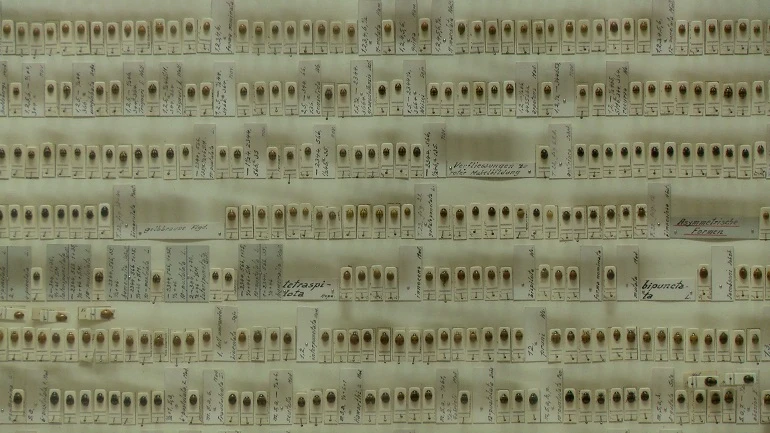
Held on 08, 09, 10, 15, 16, 17, 18, 23, 24, 27, 30 abr, 04, 08, 11 may 2015
This series explores how the museum has been conceived, represented and questioned in different film poetics. Filming the museum institution entails not only a discussion on how art is exhibited and its mechanism of interpretation, but also how other past times in the present are inserted and reactivated, articulating an amalgamation of transience, inside and outside the present, that is specific to the museum and its narrations.
This series, in relation to the exhibition devoted to the Kunstmuseum Basel, also encompasses the different “species” of museums throughout their recent history: the museum as a space of encyclopaedic knowledge and discourse, the museum as a huge institutional mechanism, the museum linked to accumulation as the dispossession of European colonialism, the museum as a Trojan Horse in operations of “reordering” and “embellishing” the contemporary city, and also the museum as one of the few contemporary spaces to rediscover memory and identity.
Más actividades
![Metahaven, The Sprawl: Propaganda about Propaganda [La diseminación: propaganda sobre propaganda], 2015, película](https://recursos.museoreinasofia.es/styles/small_landscape/public/Actividades/interfaz_emotiva_0.jpeg.webp)
EMOTIVE INTERFACE. The Films of Metahaven
Thursday, 27, Friday, 28, and Saturday, 29 November 2025 – check times
The Museo Reina Sofía and the Márgenes International Film Festival in Madrid, here in its fifteenth edition, present this series devoted to the artist collective Metahaven. The programme is framed inside the working strand both institutions started in 2024, focusing on an exploration of contemporary audiovisual narratives, a hybridisation of languages and the moving image as a tool for practising critical gazes on the present. Emotive Interface. The Films of Metahaven comprises two sessions of screenings and a masterclass delivered by the collective, centring on the relationship between the internet, technology, time and the moving image. All sessions will be presented by the artists.
The work of Metahaven — Dutch artist duo Vinca Kruk and Daniel Van der Velden — encompasses graphic art, video, installations, writing and design around urgent issues related to governance, identity, power and transparency in the digital age. Thus, their practice stands at the crossroads of art, film and critical thought, as they employ visual language as a tool to explore the tensions between technology, politics and perception, their practice combining the rigour of the visual essay and a strong poetic component, where graphic design, digital animation and documentary material fuse into dense, emotionally ambiguous compositions that speak of post-digital romanticism through an allegorical formulation. The spotlight of this series shines brightly on some of Metahaven’s recent works, for instance The Feeling Sonnets (Transitional Object) (2024), in which they examine language, poetry and digital time, and on The Sprawl (Propaganda About Propaganda) (2015), an essay which explores how the internet and social media have radically altered the relationship between truth, power and perception. Finally, the duo’s masterclass is set forth here as a survey of the main themes explored by both artists.
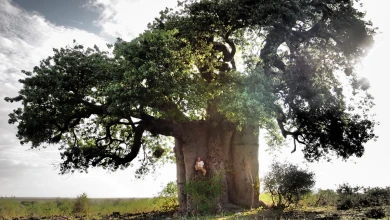
Francisco López and Barbara Ellison
Thursday, 11 December - 8pm
The third session in the series brings together two international reference points in sound art in one evening — two independent performances which converse through their proximity here. Barbara Ellison opens proceedings with a piece centred on the perceptively ambiguous and the ghostly, where voices, sounds and materials become spectral manifestations.
This is followed by Francisco López, an internationally renowned Spanish sound artist, who presents one of his radical immersions in deep listening, with his work an invitation to submerge oneself in sound matter as a transformative experience.
This double session sets forth an encounter between two artists who, from different perspectives, share the same search: to open ears to territories where sound becomes a poetic force and space of resistance.
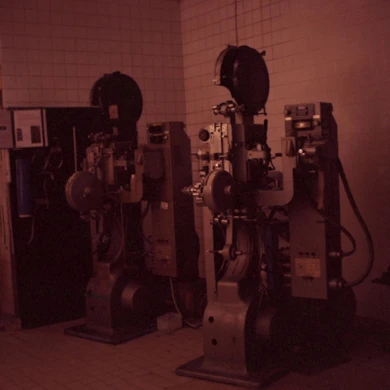
Long Live L’Abo! Celluloid and Activism
4, 5, 6 DIC 2025
L’Abominable is a collective film laboratory founded in La Courneuve (Paris, France) in 1996. It came into being in response to the disappearing infrastructures in artisan film-making and to provide artists and film-makers with a self-managed space from which to produce, develop and screen films in analogue formats such as Super 8, 16mm and 35mm. Anchored in this premise, the community promotes aesthetic and political experimentation in analogue film opposite digital hegemony. Over the years, L’Abominable, better known as L’Abo, has accompanied different generations of film-makers, upholding an international movement of independent film practices.
This third segment is structured in three sessions: a lecture on L’Abo given by Pilar Monsell and Camilo Restrepo; a session of short films in 16mm produced in L’Abo; and the feature-length film Une isle, une nuit, made by the Les Pirates des Lentillères collective.
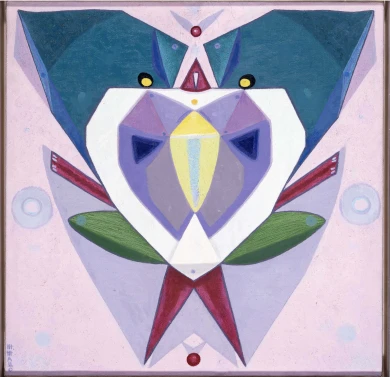
Estrella de Diego Lecture. Holding Your Brain While You Sleep
Wednesday, 3 December 2025 – 7pm
Framed inside the Museo Reina Sofía’s retrospective exhibition devoted to Maruja Mallo, this lecture delivered by Estrella de Diego draws attention to the impact of the artist’s return to Spain after her three-decade exile in Latin America.
Committed to values of progress and renewal in the Second Republic, Mallo was forced into exile to Argentina with the outbreak of the Civil War and would not go back to Spain to settle definitively until 1965 — a return that was, ultimately, a second exile.
Mallo saw out her prolific artistic trajectory with two impactful series: Moradores del vacío (Dwellers of the Void, 1968–1980) and Viajeros del éter (Ether Travelers, 1982), entering her most esoteric period in which she drew inspiration from her “levitational experiences” of crossing the Andes and sailing the Pacific. Her travels, both real and imaginary, became encounters with superhuman dimensions.
In parallel, her public persona gained traction as she became a popular figure and a key representative of the Generation of ‘27 — the other members of which also started returning to Spain.
This lecture is part of the Art and Exile series, which seeks to explore in greater depth one of the defining aspects of Maruja Mallo’s life and work: her experience of exile. An experience which for Mallo was twofold: the time she spent in the Americas and her complex return to Spain.
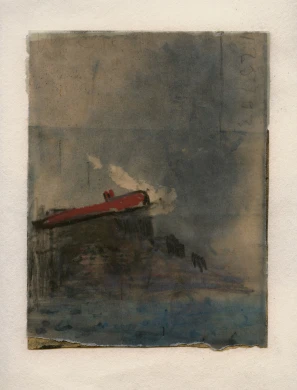
Juan Uslé. That Ship on the Mountain
Tuesday, 25 November 2025 – 7pm
Ángel Calvo Ulloa, curator of the exhibition Juan Uslé. That Ship on the Mountain, engages in conversation with artist Juan Uslé (Santander, 1954) in the Museo’s Auditorium 400 to explore in greater depth the exhibition discourse of this anthological show spanning four decades of Uslé’s artistic career.
The show casts light on the close relationship Uslé’s work bears to his life experiences, establishing connections between different stages and series which could ostensibly seem distant. Framed in this context, the conversation looks to explore the artist’s personal and professional journey: his memories, experiences of New York, his creative process, conception of painting, and ties with photography and film, and the cohesiveness and versatility that characterise his art. Key aspects for a more in-depth understanding of his artistic sphere.
The conversation, moreover, spotlights the preparatory research process that has given rise to this exhibition to grant a better understanding of the curatorial criteria and decisions that have guided its development.
These inaugural conversations, part of the main working strands of the Museo’s Public Programmes Area, aim to explore in greater depth the exhibition narratives of the shows organised by the Museo from the perspective of artists, curators and specialists.
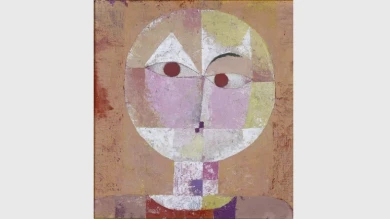



![Miguel Brieva, ilustración de la novela infantil Manuela y los Cakirukos (Reservoir Books, 2022) [izquierda] y Cibeles no conduzcas, 2023 [derecha]. Cortesía del artista](https://recursos.museoreinasofia.es/styles/small_landscape/public/Actividades/ecologias_del_deseo_utopico.jpg.webp)
![Ángel Alonso, Charbon [Carbón], 1964. Museo Reina Sofía](https://recursos.museoreinasofia.es/styles/small_landscape/public/Actividades/perspectivas_ecoambientales.jpg.webp)